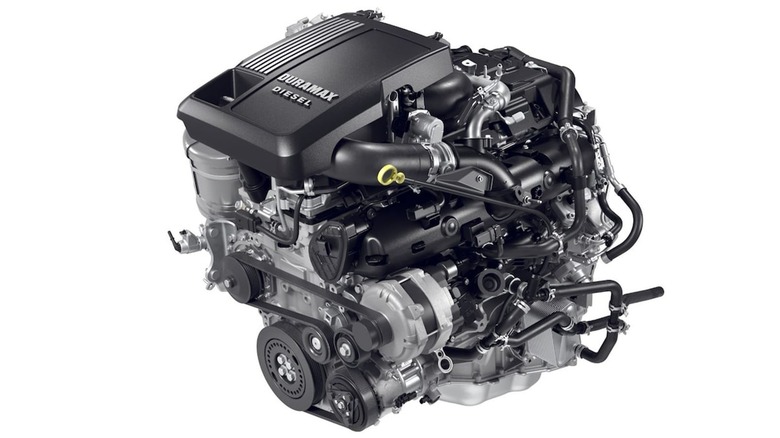3 Of The Most Common Problems Drivers Report With The 3.0 Duramax Diesel Engine
General Motors' Duramax diesel engine lineup has been powering GM trucks and SUVs and enthralling gearheads since its original release in 2001. While the most famous member of the Duramax roster is the 6.6-liter V8 found in GM's heavy-duty pickup and SUV lines, it's not the only motor to get the Duramax badge. Smaller Duramax engines — including two 2.8-liter engines and one 2.5-liter engine — were released in 2011, 2012, and 2014. However, the real game-changer came in 2019, when General Motors released its much-anticipated 3.0-liter, inline-six Duramax diesel engine.
The modern motor produces exceptional fuel economy and around 300 horsepower. In fact, 3.0-liter Duramax-powered pickups are some of the most fuel-efficient diesel trucks on the market today. You can find this engine in vehicles like the Silverado 1500, Sierra 1500, Tahoe, Suburban, and even the Cadillac Escalade, making the 3.0L Duramax the only diesel option currently available in mainstream half-ton pickups.
But for everything that makes the 3.0L Duramax diesel engine great, it also has its flaws. Several issues, in particular, are known to plague the engine and have caused many drivers to think twice before dropping big bucks on vehicles equipped with the 3.0L Duramax. From getting the motor to start to catastrophic oil leaks, here are three of the most common problems drivers report with the 3.0L Duramax diesel engine.
The 3.0L Duramax has long crank times, or the vehicle won't start
One of the most pervasive issues that some owners have faced with the 3.0-liter Duramax is a long crank time or no start condition. That means that when drivers go to start the engine, it does one of two things: it takes an exceptionally long time to start, or the engine doesn't start at all. Many drivers report experiencing this issue intermittently. General Motors has released several technical service bulletins (TSB) for the situation, each describing various causes and solutions. However, one of the primary causes of this condition for the 3.0L Duramax diesel engines appears to be a faulty camshaft trigger wheel, a component that works with the camshaft position sensor to send information to the car's computer. In these cases, the trigger wheel may come into contact with the engine's timing chain, disrupting the motor's ignition process and resulting in a long crank or no start condition.
General Motors suggests replacing the camshaft trigger wheel as a potential fix, and one TSB claims that the repair process takes 3.1 hours of labor time. However, many drivers report that GM had to remove the entire cab from their pickups to fix the issue, a 40- to 50-hour long process that costs a pretty penny. Other potential fixes for the long crank or no start condition include replacing faulty wiring harnesses, installing a shim to the camshaft position sensor, and recalibrating the Engine Control Unit (ECU). Though the company has released several TSBs regarding the issue, there have been no recalls. And even though GM has offered a few potential fixes, many drivers report the issues returning, even after GM performs the repair.
Oil leaks due to failure of the rear main seal is a common 3.0L Duramax issue
Another problem that's hounded the 3.0L Duramax diesel engines is major oil leakage. In many cases, drivers report experiencing catastrophic oil leaks after putting very few miles on their vehicles. Most of these issues appear to be due to a faulty rear main seal.
The rear main seal separates the engine from the transmission and prevents oil from leaking out of the crankcase. When these seals fail, it's common for the engine to lose nearly all its oil very quickly. This can be a disastrous situation, as drivers may not be aware of the problem while moving down the road. And if the engine loses its oil while running, it can quickly develop severe problems, including broken internal components or complete seizure.
General Motors has issued a TSB for this problem and recommends replacing the lower timing chain cover, which comes with a new seal. The repair takes roughly 12 hours to complete, meaning drivers affected by this issue will most likely be without their vehicles for two to three days. However, the upside is that these issues seem to occur after drivers put relatively few miles on their engines — usually below 20,000 miles — which means that GM's warranty should cover the repair for most affected owners.
The 3.0L Duramax can experience emissions system problems
One of the more cryptic issues that some 3.0L Duramax owners have encountered is a faulty emissions system. Many drivers report experiencing these problems with extremely low miles and receiving mixed information from GM dealerships. In some cases, the issue appears to be related to the diesel exhaust fluid (DEF) system. In other cases, the issue seems to be due to faulty sensors within the exhaust system.
The most frustrating part of this problem for drivers is that General Motors itself doesn't appear to understand what the ultimate root cause is, or if it's even the same problem affecting various owners. Many drivers report taking their vehicles to the GM dealership for repairs, only to experience the same problem a few days after the dealership "fixes" it.
Anyone who has worked on cars for a while knows that emissions systems are notoriously finicky, and problems with these systems can be incredibly difficult to pinpoint and repair. However, that's probably little comfort to most affected drivers who need their vehicles. While the 3.0L Duramax is a relatively young engine, and its issues are bound to be smoothed out in the coming years, these pervasive issues are certainly concerning for current owners. And if you're in the market for a smaller diesel pickup, some drivers who have lived through their own 3.0L Duramax problems recommend shopping elsewhere while GM sorts out its issues.



